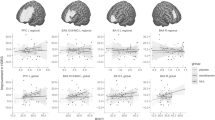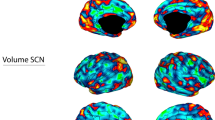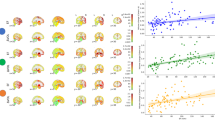Abstract
Transcranial direct current stimulation (tDCS) has been used as treatment for depression, but its effects are heterogeneous. We investigated, in a subsample of the clinical trial Escitalopram versus Electrical Direct Current Therapy for Depression Study (ELECTTDCS), whether white matter areas associated with depression disorder were associated with tDCS response. Baseline diffusion tensor imaging data were analyzed from 49 patients (34 females, mean age 41.9) randomized to escitalopram 20 mg/day, tDCS (2 mA, 30 min, 22 sessions), or placebo. Antidepressant outcomes were assessed by Hamilton Depression Rating Scale-17 (HDRS) after 10-week treatment. We used whole-brain tractography for extracting white matter measures for anterior corpus callosum, and bilaterally for cingulum bundle, striato-frontal, inferior occipito-frontal fasciculus and uncinate. For the rostral body, tDCS group showed higher MD associated with antidepressant effects (estimate = −5.13 ± 1.64, p = 0.002), and tDCS significantly differed from the placebo and the escitalopram group. The left striato-frontal tract showed higher FA associated with antidepressant effects (estimate = −2.14 ± 0.72, p = 0.003), and tDCS differed only from the placebo group. For the right uncinate, the tDCS group lower AD values were associated with higher HDRS decrease (estimate = −1.45 ± 0.67, p = 0.031). Abnormalities in white matter MDD-related areas are associated with tDCS antidepressant effects. Suggested better white matter microstructure of the left prefrontal cortex was associated with tDCS antidepressant effects. Future studies should investigate whether these findings are driven by electric field diffusion and density in these areas.



Similar content being viewed by others
Abbreviations
- DTI:
-
Diffusion tensor imaging
- ELECT-TDCS:
-
Escitalopram versus electrical current therapy for treating depression clinical study
- FA:
-
Fractional anisotropy
- HDRS-17:
-
Hamilton depression rating scale
- MDD:
-
Major depressive disorder
- MRI:
-
Magnetic resonance imaging
- tDCS:
-
Transcranial direct current stimulation
- WM:
-
White matter
- MD:
-
Mean diffusivity
References
Murray CJL, Lopez AD (2017) Measuring global health: motivation and evolution of the global burden of disease study. Lancet 390:1460–1464
Stephan KE, Bach DR, Fletcher PC, Flint J, Frank MJ, Friston KJ et al (2016) Charting the landscape of priority problems in psychiatry, part 1: classification and diagnosis. Lancet Psychiatry 3:77–83
Kendrick T, Taylor D, Johnson CF (2019) Which first-line antidepressant? Br J Gen Pract 69:114–115
Brunoni AR, Valiengo L, Baccaro A, Zanão TA, de Oliveira JF, Goulart A et al (2013) The sertraline vs electrical current therapy for treating depression clinical study: results from a factorial, randomized, controlled trial. JAMA Psychiat 70:383–391
Vittengl JR (2017) Poorer long-term outcomes among persons with major depressive disorder treated with medication. Psychother Psychosom 86:302–304
Milev RV, Giacobbe P, Kennedy SH, Blumberger DM, Daskalakis ZJ, Downar J et al (2016) Canadian network for mood and anxiety treatments (CANMAT) 2016 clinical guidelines for the management of adults with major depressive disorder: section 4. Neurostimulation Treatments Can J Psychiatry 61:561–575
Nitsche MA, Paulus W (2000) Excitability changes induced in the human motor cortex by weak transcranial direct current stimulation. J Physiol 527:633–639
Brunoni AR, Moffa AH, Sampaio-Junior B, Borrione L, Moreno ML, Fernandes RA et al (2017) Trial of electrical direct-current therapy versus escitalopram for depression. N Engl J Med 376:2523–2533
Mayberg HS, Brannan SK, Tekell JL, Silva JA, Mahurin RK, McGinnis S et al (2000) Regional metabolic effects of fluoxetine in major depression: serial changes and relationship to clinical response. Biol Psychiatry 48:830–843
Brunoni AR, Ferrucci R, Fregni F, Boggio PS, Priori A (2012) Transcranial direct current stimulation for the treatment of major depressive disorder: a summary of preclinical, clinical and translational findings. Prog Neuropsychopharmacol Biol Psychiatry 39:9–16
George MS, Ketter TA, Post RM (1994) Prefrontal cortex dysfunction in clinical depression. Depression 2:59–72
Razza LB, Palumbo P, Moffa AH, Carvalho AF, Solmi M, Loo CK et al (2020) A systematic review and meta-analysis on the effects of transcranial direct current stimulation in depressive episodes. Depress Anxiety 37:594–608
Vila-Rodriguez F, Frangou S (2021) Individualized functional targeting for rTMS: a powerful idea whose time has come? Hum Brain Mapp 42:4079–4080
Cash RFH, Cocchi L, Lv J, Fitzgerald PB, Zalesky A (2021) Functional magnetic resonance imaging-guided personalization of transcranial magnetic stimulation treatment for depression. JAMA Psychiat 78:337–339
Modak A, Fitzgerald PB (2021) Personalising transcranial magnetic stimulation for depression using neuroimaging: a systematic review. World J Biol Psychiatry 22:647–669
Cole EJ, Stimpson KH, Bentzley BS, Gulser M, Cherian K, Tischler C et al (2020) Stanford accelerated intelligent neuromodulation therapy for treatment-resistant depression. Am J Psychiatry 177:716–726
Shahid S, Wen P, Ahfock T (2014) Assessment of electric field distribution in anisotropic cortical and subcortical regions under the influence of tDCS. Bioelectromagnetics 35:41–57
Bhalerao G, Selvaraj S, Parlikar R, Sreeraj V, Shivakumar V, Damodharan D et al (2019) White matter correlates of electric field activity in HD-tDCS for schizophrenia: a computational neuromodeling study. Brain Stimul 12:503
Kalloch B, Weise K, Lampe L, Bazin P-L, Villringer A, Hlawitschka M et al (2022) The Influence of white matter lesions on the electric field in transcranial electric stimulation. SSRN Electron J. https://doi.org/10.2139/ssrn.4051561
Le Bihan D (2014) Diffusion MRI: what water tells us about the brain. EMBO Mol Med 6:569–573
Zhao Y, Ficek B, Webster K, Frangakis C, Caffo B, Hillis AE et al (2021) White matter integrity predicts electrical stimulation (tdcs) and language therapy effects in primary progressive aphasia. Neurorehabil Neural Repair 35:44–57
McConathey EM, White NC, Gervits F, Ash S, Coslett HB, Grossman M et al (2017) Baseline performance predicts tdcs-mediated improvements in language symptoms in primary progressive aphasia. Front Hum Neurosci 11:347
Podwalski P, Szczygieł K, Tyburski E, Sagan L, Misiak B, Samochowiec J (2021) Magnetic resonance diffusion tensor imaging in psychiatry: a narrative review of its potential role in diagnosis. Pharmacol Rep 73:43–56
Roelofs EF, Bas-Hoogendam JM, van der Werff SJA, Valstar SD, van der Wee NJA, Vermeiren RRJM (2021) Exploring the course of adolescent anxiety and depression: associations with white matter tract microstructure. Eur Arch Psychiatry Clin Neurosci. https://doi.org/10.1007/s00406-021-01347-8
Alexander AL, Hurley SA, Samsonov AA, Adluru N, Hosseinbor AP, Mossahebi P et al (2011) Characterization of cerebral white matter properties using quantitative magnetic resonance imaging stains. Brain Connect 1:423–446
Luque Laguna PA, Combes AJE, Streffer J, Einstein S, Timmers M, Williams SCR et al (2020) Reproducibility, reliability and variability of FA and MD in the older healthy population: a test-retest multiparametric analysis. Neuroimage Clin 26:102168
Van Velzen, Kelly, Isaev, Aleman. (2020) White matter disturbances in major depressive disorder: a coordinated analysis across 20 international cohorts in the ENIGMA MDD working group. Mol Life. Available: https://www.nature.com/articles/s41380-019-0477-2.
Emsell L, Adamson C, De Winter F-L, Billiet T, Christiaens D, Bouckaert F et al (2017) Corpus callosum macro and microstructure in late-life depression. J Affect Disord 222:63–70
Chen G, Hu X, Li L, Huang X, Lui S, Kuang W et al (2016) Disorganization of white matter architecture in major depressive disorder: a meta-analysis of diffusion tensor imaging with tract-based spatial statistics. Sci Rep 6:21825
Liao Y, Huang X, Wu Q, Yang C, Kuang W, Du M et al (2013) Is depression a disconnection syndrome? Meta- analysis of diffusion tensor imaging studies in patients with MDD. J Psychiatry Neurosci. https://doi.org/10.1503/jpn.110180
Murphy ML, Frodl T (2011) Meta-analysis of diffusion tensor imaging studies shows altered fractional anisotropy occurring in distinct brain areas in association with depression. Biol Mood Anxiety Disord 1:3
Wise T, Radua J, Nortje G, Cleare AJ, Young AH, Arnone D (2016) Voxel-based meta-analytical evidence of structural disconnectivity in major depression and bipolar disorder. Biol Psychiatry 79:293–302
Fettes P, Schulze L, Downar J (2017) Cortico-striatal-thalamic loop circuits of the orbitofrontal cortex: promising therapeutic targets in psychiatric illness. Front Syst Neurosci 11:25
Schmahmann JD, Pandya DN, Wang R, Dai G, D’Arceuil HE, de Crespigny AJ et al (2007) Association fibre pathways of the brain: parallel observations from diffusion spectrum imaging and autoradiography. Brain 130:630–653
Wagner G, Koch K, Schachtzabel C, Reichenbach JR, Sauer H, Schlösser Md RGM (2008) Enhanced rostral anterior cingulate cortex activation during cognitive control is related to orbitofrontal volume reduction in unipolar depression. J Psychiatry Neurosci 33:199–208
Picó-Pérez M, Radua J, Steward T, Menchón JM, Soriano-Mas C (2017) Emotion regulation in mood and anxiety disorders: a meta-analysis of fMRI cognitive reappraisal studies. Prog Neuropsychopharmacol Biol Psychiatry 79:96–104
Phan KL, Wager T, Taylor SF, Liberzon I (2002) Functional neuroanatomy of emotion: a meta-analysis of emotion activation studies in PET and fMRI. Neuroimage 16:331–348
Matsuo K, Glahn DC, Peluso MAM, Hatch JP, Monkul ES, Najt P et al (2007) Prefrontal hyperactivation during working memory task in untreated individuals with major depressive disorder. Mol Psychiatry. https://doi.org/10.1038/sj.mp.4001894
Brunoni AR, Sampaio-Junior B, Moffa AH, Borrione L, Nogueira BS, Aparício LVM et al (2015) The escitalopram versus electric current therapy for treating depression clinical study (ELECT-TDCS): rationale and study design of a non-inferiority, triple-arm, placebo-controlled clinical trial. Sao Paulo Med J 133:252–263
Seibt O, Brunoni AR, Huang Y, Bikson M (2015) The pursuit of DLPFC: non-neuronavigated methods to target the left dorsolateral pre-frontal cortex with symmetric bicephalic transcranial direct current stimulation (tDCS). Brain Stimul 8:590–602
Jenkinson M, Bannister P, Brady M, Smith S (2002) Improved optimization for the robust and accurate linear registration and motion correction of brain images. Neuroimage 17:825–841
Jenkinson M, Smith S (2001) A global optimisation method for robust affine registration of brain images. Med Image Anal 5:143–156
Greve DN, Fischl B (2009) Accurate and robust brain image alignment using boundary-based registration. Neuroimage 48:63–72
Fedorov A, Beichel R, Kalpathy-Cramer J, Finet J, Fillion-Robin J-C, Pujol S et al (2012) 3D Slicer as an image computing platform for the quantitative imaging network. Magn Reson Imaging 30:1323–1341
Malcolm JG, Shenton ME, Rathi Y (2010) Filtered multitensor tractography. IEEE Trans Med Imaging 29:1664–1675
Zhang F, Wu Y, Norton I, Rigolo L, Rathi Y, Makris N et al (2018) An anatomically curated fiber clustering white matter atlas for consistent white matter tract parcellation across the lifespan. Neuroimage 179:429–447
Zhang F, Noh T, Juvekar P, Frisken SF, Rigolo L, Norton I et al (2020) SlicerDMRI: diffusion mri and tractography research software for brain cancer surgery planning and visualization. JCO Clin Cancer Inform 4:299–309
Zhang F, Wu Y, Norton I, Rathi Y, Golby AJ, O’Donnell LJ (2019) Test-retest reproducibility of white matter parcellation using diffusion MRI tractography fiber clustering. Hum Brain Mapp 40:3041–3057
O’Donnell LJ, Wells WM 3rd, Golby AJ, Westin C-F (2012) Unbiased groupwise registration of white matter tractography. Med Image Comput Comput Assist Interv 15:123–130
Zekelman LR, Zhang F, Makris N, He J, Chen Y, Xue T et al (2022) White matter association tracts underlying language and theory of mind: an investigation of 809 brains from the human connectome project. Neuroimage 246:118739
Witelson SF (1989) Hand and sex differences in the isthmus and genu of the human corpus callosum postmortem morphological study. Brain 112(Pt 3):799–835
Norton I, Essayed WI, Zhang F, Pujol S, Yarmarkovich A, Golby AJ et al (2017) SlicerDMRI: open source diffusion mri software for brain cancer research. Cancer Res 77:e101–e103
Assaf Y, Pasternak O (2008) Diffusion tensor imaging (DTI)-based white matter mapping in brain research: a review. J Mol Neurosci 34:51–61
Makris N, Meyer JW, Bates JF, Yeterian EH, Kennedy DN, Caviness VS (1999) MRI-based topographic parcellation of human cerebral white matter and nuclei. Neuroimage. https://doi.org/10.1006/nimg.1998.0384
Shah A, Jhawar S, Goel A, Goel A (2021) Corpus callosum and its connections: a fiber dissection study. World Neurosurg 151:e1024–e1035
Kurtin DL, Violante IR, Zimmerman K, Leech R, Hampshire A, Patel MC et al (2021) Investigating the interaction between white matter and brain state on tDCS-induced changes in brain network activity. Brain Stimul 14:1261–1270
Vieira R, Coelho A, Reis J, Portugal-Nunes C, Magalhães R, Ferreira S et al (2021) White matter microstructure alterations associated with paroxetine treatment response in major depression. Front Behav Neurosci 15:693109
Davis AD, Hassel S, Arnott SR, Harris J, Lam RW, Milev R et al (2019) White matter indices of medication response in major depression: a diffusion tensor imaging study. Biol Psychiatry Cogn Neurosci Neuroimaging 4:913–924
Vasavada MM, Leaver AM, Espinoza RT, Joshi SH, Njau SN, Woods RP et al (2016) Structural connectivity and response to ketamine therapy in major depression: a preliminary study. J Affect Disord 190:836–841
Coenen VA, Panksepp J, Hurwitz TA, Urbach H, Mädler B (2012) Human medial forebrain bundle (MFB) and anterior thalamic radiation (ATR): imaging of two major subcortical pathways and the dynamic balance of opposite affects in understanding depression. J Neuropsychiatry Clin Neurosci 24:223–236
Coenen VA, Bewernick BH, Kayser S, Kilian H, Boström J, Greschus S et al (2019) Superolateral medial forebrain bundle deep brain stimulation in major depression: a gateway trial. Neuropsychopharmacology 44:1224–1232
Schlaepfer TE, Cohen MX, Frick C, Kosel M, Brodesser D, Axmacher N et al (2008) Deep brain stimulation to reward circuitry alleviates anhedonia in refractory major depression. Neuropsychopharmacology 33:368–377
Bulubas L, Padberg F, Bueno PV, Duran F, Busatto G, Amaro E Jr et al (2019) Antidepressant effects of tDCS are associated with prefrontal gray matter volumes at baseline: evidence from the ELECT-TDCS trial. Brain Stimul 12:1197–1204
Woods AJ, Antal A, Bikson M, Boggio PS, Brunoni AR, Celnik P et al (2016) A technical guide to tDCS, and related non-invasive brain stimulation tools. Clin Neurophysiol 127:1031–1048
Vergallito A, Feroldi S, Pisoni A, Romero Lauro LJ (2022) Inter-individual variability in tDCS effects: a narrative review on the contribution of stable, variable, and contextual factors. Brain Sci. https://doi.org/10.3390/brainsci12050522
Grieve SM, Korgaonkar MS, Gordon E, Williams LM, Rush AJ (2016) Prediction of nonremission to antidepressant therapy using diffusion tensor imaging. J Clin Psychiatry 77:e436–e443
Bulubas L, Padberg F, Mezger E, Suen P, Bueno PV, Duran F et al (2021) Prefrontal resting-state connectivity and antidepressant response: no associations in the ELECT-TDCS trial. Eur Arch Psychiatry Clin Neurosci 271:123–134
Suen PJC, Doll S, Batistuzzo MC, Busatto G, Razza LB, Padberg F et al (2021) Association between tDCS computational modeling and clinical outcomes in depression: data from the ELECT-TDCS trial. Eur Arch Psychiatry Clin Neurosci 271:101–110
Zhan L, Zhou J, Wang Y, Jin Y, Jahanshad N, Prasad G et al (2015) Comparison of nine tractography algorithms for detecting abnormal structural brain networks in Alzheimer’s disease. Front Aging Neurosci. https://doi.org/10.3389/fnagi.2015.00048
Acknowledgements
This study was primarily supported by a FAPESP grant (2012/20911-5). ARB is a recipient of a UK Newton Advanced Fellow (2020–2022)—Oxford University and FAPESP grant (2019/06009-6); TZ and MSL are recipient of FAPESP grants (2020/03235-2 and 2021/10574-0, respectively).
Funding
ELECT-TDCS funding: Sao Paulo Research State Foundation (FAPESP) and others. Registration: ClinicalTrials.gov NCT01894815.
Author information
Authors and Affiliations
Corresponding author
Ethics declarations
Conflict of interest
The authors have no conflicts of interest to declare.
Supplementary Information
Below is the link to the electronic supplementary material.
Rights and permissions
Springer Nature or its licensor (e.g. a society or other partner) holds exclusive rights to this article under a publishing agreement with the author(s) or other rightsholder(s); author self-archiving of the accepted manuscript version of this article is solely governed by the terms of such publishing agreement and applicable law.
About this article
Cite this article
Zanao, T.A., Luethi, M.S., Goerigk, S. et al. White matter predicts tDCS antidepressant effects in a sham-controlled clinical trial study. Eur Arch Psychiatry Clin Neurosci 273, 1421–1431 (2023). https://doi.org/10.1007/s00406-022-01504-7
Received:
Accepted:
Published:
Issue Date:
DOI: https://doi.org/10.1007/s00406-022-01504-7




